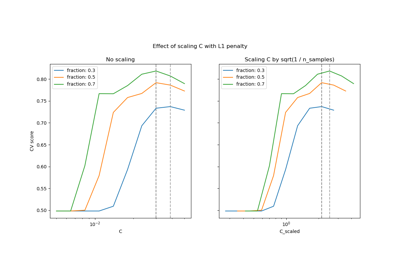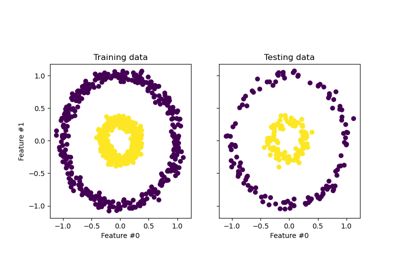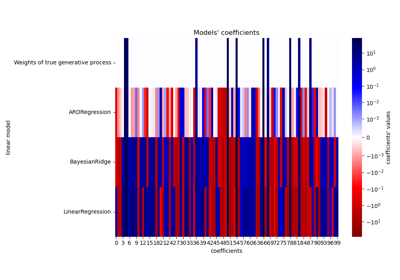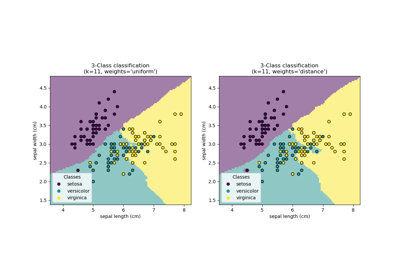Note
Go to the end to download the full example code or to run this example in your browser via JupyterLite or Binder.
Importance of Feature Scaling#
Feature scaling through standardization, also called Z-score normalization, is an important preprocessing step for many machine learning algorithms. It involves rescaling each feature such that it has a standard deviation of 1 and a mean of 0.
Even if tree based models are (almost) not affected by scaling, many other algorithms require features to be normalized, often for different reasons: to ease the convergence (such as a non-penalized logistic regression), to create a completely different model fit compared to the fit with unscaled data (such as KNeighbors models). The latter is demonstrated on the first part of the present example.
On the second part of the example we show how Principal Component Analysis (PCA)
is impacted by normalization of features. To illustrate this, we compare the
principal components found using PCA on unscaled
data with those obtained when using a
StandardScaler to scale data first.
In the last part of the example we show the effect of the normalization on the accuracy of a model trained on PCA-reduced data.
# Authors: The scikit-learn developers
# SPDX-License-Identifier: BSD-3-Clause
Load and prepare data#
The dataset used is the Wine recognition dataset available at UCI. This dataset has continuous features that are heterogeneous in scale due to differing properties that they measure (e.g. alcohol content and malic acid).
from sklearn.datasets import load_wine
from sklearn.model_selection import train_test_split
from sklearn.preprocessing import StandardScaler
X, y = load_wine(return_X_y=True, as_frame=True)
scaler = StandardScaler().set_output(transform="pandas")
X_train, X_test, y_train, y_test = train_test_split(
X, y, test_size=0.30, random_state=42
)
scaled_X_train = scaler.fit_transform(X_train)
Effect of rescaling on a k-neighbors models#
For the sake of visualizing the decision boundary of a
KNeighborsClassifier, in this section we select a
subset of 2 features that have values with different orders of magnitude.
Keep in mind that using a subset of the features to train the model may likely leave out feature with high predictive impact, resulting in a decision boundary that is much worse in comparison to a model trained on the full set of features.
import matplotlib.pyplot as plt
from sklearn.inspection import DecisionBoundaryDisplay
from sklearn.neighbors import KNeighborsClassifier
X_plot = X[["proline", "hue"]]
X_plot_scaled = scaler.fit_transform(X_plot)
clf = KNeighborsClassifier(n_neighbors=20)
def fit_and_plot_model(X_plot, y, clf, ax):
clf.fit(X_plot, y)
disp = DecisionBoundaryDisplay.from_estimator(
clf,
X_plot,
response_method="predict",
alpha=0.5,
ax=ax,
)
disp.ax_.scatter(X_plot["proline"], X_plot["hue"], c=y, s=20, edgecolor="k")
disp.ax_.set_xlim((X_plot["proline"].min(), X_plot["proline"].max()))
disp.ax_.set_ylim((X_plot["hue"].min(), X_plot["hue"].max()))
return disp.ax_
fig, (ax1, ax2) = plt.subplots(ncols=2, figsize=(12, 6))
fit_and_plot_model(X_plot, y, clf, ax1)
ax1.set_title("KNN without scaling")
fit_and_plot_model(X_plot_scaled, y, clf, ax2)
ax2.set_xlabel("scaled proline")
ax2.set_ylabel("scaled hue")
_ = ax2.set_title("KNN with scaling")
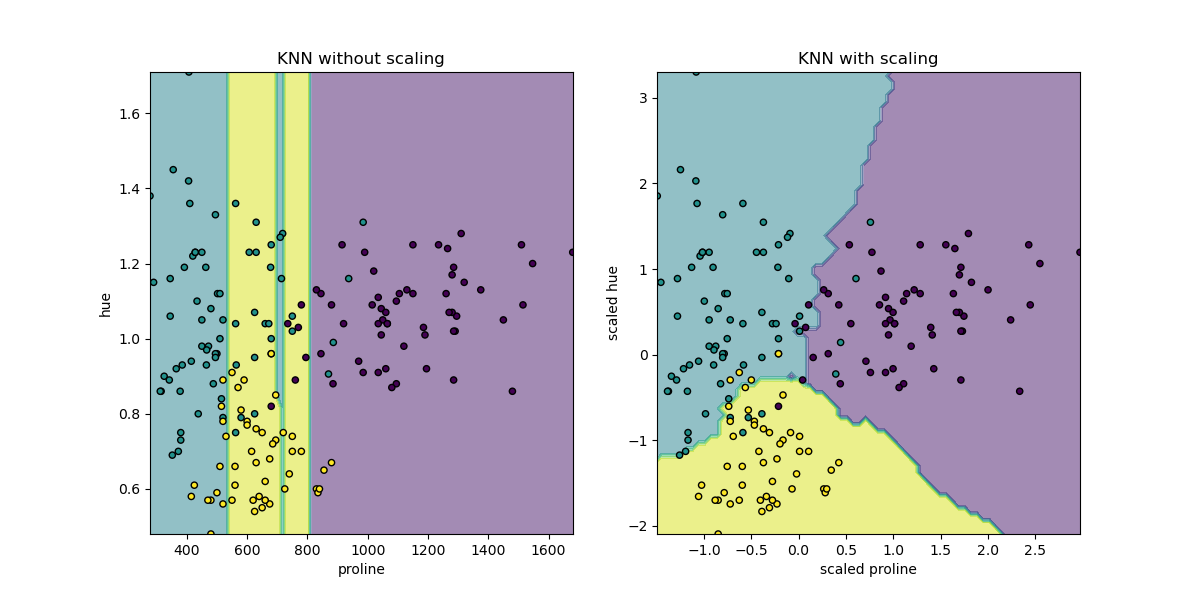
Here the decision boundary shows that fitting scaled or non-scaled data lead
to completely different models. The reason is that the variable “proline” has
values which vary between 0 and 1,000; whereas the variable “hue” varies
between 1 and 10. Because of this, distances between samples are mostly
impacted by differences in values of “proline”, while values of the “hue” will
be comparatively ignored. If one uses
StandardScaler to normalize this database,
both scaled values lay approximately between -3 and 3 and the neighbors
structure will be impacted more or less equivalently by both variables.
Effect of rescaling on a PCA dimensional reduction#
Dimensional reduction using PCA consists of
finding the features that maximize the variance. If one feature varies more
than the others only because of their respective scales,
PCA would determine that such feature
dominates the direction of the principal components.
We can inspect the first principal components using all the original features:
import pandas as pd
from sklearn.decomposition import PCA
pca = PCA(n_components=2).fit(X_train)
scaled_pca = PCA(n_components=2).fit(scaled_X_train)
X_train_transformed = pca.transform(X_train)
X_train_std_transformed = scaled_pca.transform(scaled_X_train)
first_pca_component = pd.DataFrame(
pca.components_[0], index=X.columns, columns=["without scaling"]
)
first_pca_component["with scaling"] = scaled_pca.components_[0]
first_pca_component.plot.bar(
title="Weights of the first principal component", figsize=(6, 8)
)
_ = plt.tight_layout()
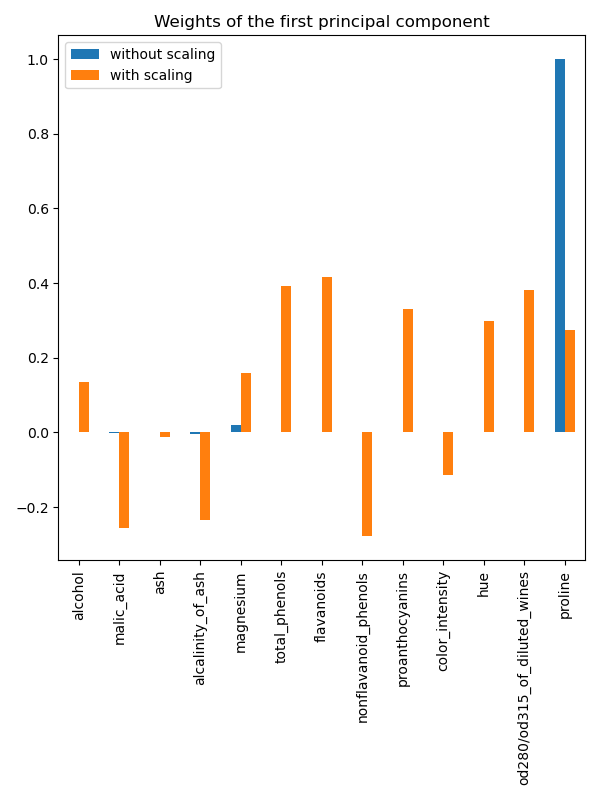
Indeed we find that the “proline” feature dominates the direction of the first principal component without scaling, being about two orders of magnitude above the other features. This is contrasted when observing the first principal component for the scaled version of the data, where the orders of magnitude are roughly the same across all the features.
We can visualize the distribution of the principal components in both cases:
fig, (ax1, ax2) = plt.subplots(nrows=1, ncols=2, figsize=(10, 5))
target_classes = range(0, 3)
colors = ("blue", "red", "green")
markers = ("^", "s", "o")
for target_class, color, marker in zip(target_classes, colors, markers):
ax1.scatter(
x=X_train_transformed[y_train == target_class, 0],
y=X_train_transformed[y_train == target_class, 1],
color=color,
label=f"class {target_class}",
alpha=0.5,
marker=marker,
)
ax2.scatter(
x=X_train_std_transformed[y_train == target_class, 0],
y=X_train_std_transformed[y_train == target_class, 1],
color=color,
label=f"class {target_class}",
alpha=0.5,
marker=marker,
)
ax1.set_title("Unscaled training dataset after PCA")
ax2.set_title("Standardized training dataset after PCA")
for ax in (ax1, ax2):
ax.set_xlabel("1st principal component")
ax.set_ylabel("2nd principal component")
ax.legend(loc="upper right")
ax.grid()
_ = plt.tight_layout()
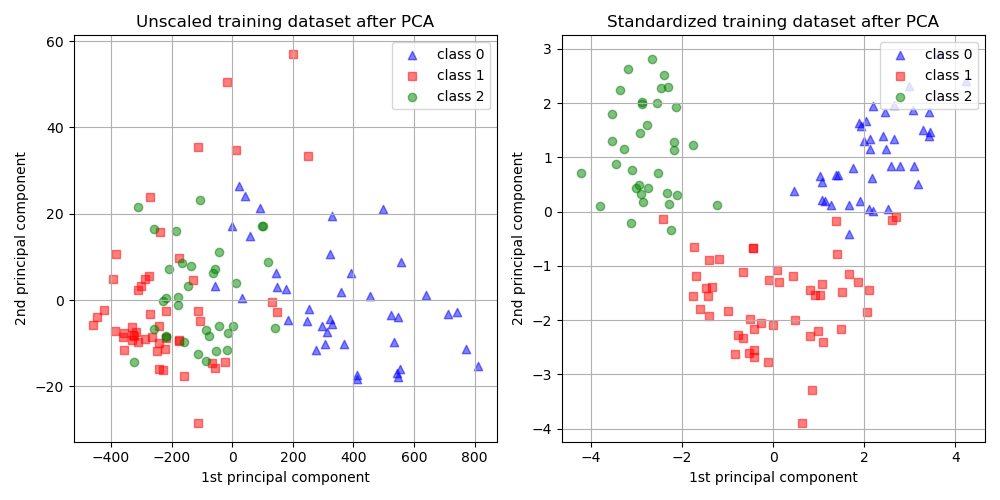
From the plot above we observe that scaling the features before reducing the dimensionality results in components with the same order of magnitude. In this case it also improves the separability of the classes. Indeed, in the next section we confirm that a better separability has a good repercussion on the overall model’s performance.
Effect of rescaling on model’s performance#
First we show how the optimal regularization of a
LogisticRegressionCV depends on the scaling or
non-scaling of the data:
import numpy as np
from sklearn.linear_model import LogisticRegressionCV
from sklearn.pipeline import make_pipeline
Cs = np.logspace(-5, 5, 20)
unscaled_clf = make_pipeline(
pca, LogisticRegressionCV(Cs=Cs, use_legacy_attributes=False, l1_ratios=(0,))
)
unscaled_clf.fit(X_train, y_train)
scaled_clf = make_pipeline(
scaler,
pca,
LogisticRegressionCV(Cs=Cs, use_legacy_attributes=False, l1_ratios=(0,)),
)
scaled_clf.fit(X_train, y_train)
print(f"Optimal C for the unscaled PCA: {unscaled_clf[-1].C_:.4f}\n")
print(f"Optimal C for the standardized data with PCA: {scaled_clf[-1].C_:.2f}")
Optimal C for the unscaled PCA: 0.0004
Optimal C for the standardized data with PCA: 20.69
The need for regularization is higher (lower values of C) for the data that
was not scaled before applying PCA. We now evaluate the effect of scaling on
the accuracy and the mean log-loss of the optimal models:
from sklearn.metrics import accuracy_score, log_loss
y_pred = unscaled_clf.predict(X_test)
y_pred_scaled = scaled_clf.predict(X_test)
y_proba = unscaled_clf.predict_proba(X_test)
y_proba_scaled = scaled_clf.predict_proba(X_test)
print("Test accuracy for the unscaled PCA")
print(f"{accuracy_score(y_test, y_pred):.2%}\n")
print("Test accuracy for the standardized data with PCA")
print(f"{accuracy_score(y_test, y_pred_scaled):.2%}\n")
print("Log-loss for the unscaled PCA")
print(f"{log_loss(y_test, y_proba):.3}\n")
print("Log-loss for the standardized data with PCA")
print(f"{log_loss(y_test, y_proba_scaled):.3}")
Test accuracy for the unscaled PCA
35.19%
Test accuracy for the standardized data with PCA
96.30%
Log-loss for the unscaled PCA
0.957
Log-loss for the standardized data with PCA
0.0825
A clear difference in prediction accuracies is observed when the data is
scaled before PCA, as it vastly outperforms
the unscaled version. This corresponds to the intuition obtained from the plot
in the previous section, where the components become linearly separable when
scaling before using PCA.
Notice that in this case the models with scaled features perform better than the models with non-scaled features because all the variables are expected to be predictive and we rather avoid some of them being comparatively ignored.
If the variables in lower scales were not predictive, one may experience a decrease of the performance after scaling the features: noisy features would contribute more to the prediction after scaling and therefore scaling would increase overfitting.
Last but not least, we observe that one achieves a lower log-loss by means of the scaling step.
Total running time of the script: (0 minutes 1.086 seconds)
Related examples
